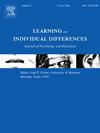Intraindividual dynamics of primary school students' executive functioning: Accuracy and response-time
IF 9
1区 心理学
Q1 PSYCHOLOGY, EDUCATIONAL
引用次数: 0
Abstract
We go beyond cross-sectional studies of executive functioning (EF) to investigate intraindividual dynamics of accuracy and response-times. Forty-three 8–11 year-old children (Mage = 9 years 11 months, 51.2 % boys) completed the Mixed block (including both congruent and incongruent trials) of the Hearts and Flowers task on tablets twice per school-day during two weeks (nti = 651). Specifying Residual Dynamic Structural Equation Models (RDSEM) novel findings emerged. Children became less accurate and respond faster over time. Both state-accuracy and state-response-time were relatively stable over time. State-accuracy-on-response-time-slopes showed that children with a relatively lower trait-accuracy performed more accurately when they slowed down. In contrast, children with a relatively higher trait-accuracy performed at the same level of accuracy regardless whether they accelerated or decelerated. An intraindividual approach to EF provides an important window into the children's accuracy-speed trade-off and cognition in a naturalistic school context.
Educational relevance
While developmental trends of children's executive functions and between-person differences are relatively well established in the literature, we know less about the processes from situation to situation in everyday learning environments. For learning, children rely on their self-monitoring and self-regulation to adjust their pace in learning contexts, for example slowing down for new topics, or speeding up for known contents. Teachers monitor children's accuracy both as immediate and longer-term outcomes, and can provide feedback to them in case they need to slow down, or nudge them to speed up in learning situations. In order to understand how children regulate this speed/accuracy trade-off from one lesson to another, from one day to another, we investigated how their executive functions (EF) unfolded during lessons and days at school. In particular, we investigated the dynamics between accuracies (how correctly they responded) and response times (how fast they responded) when they completed the Mixed bock of the Hearts and Flowers executive function task up to twice a day for ten school days. Importantly we found when children with lower overall accuracy performed more accurately when they slowed down, while speed had no impact on the accuracy of children with higher overall accuracy. This speed/accuracy trade-off is as important for learning tasks at school as it is for completing EF tasks. Understanding how this speed/accuracy trade-off ebbs and flows lesson-to-lesson and day-to-day for different children gives unique insights into variability in cognitive capacities that teachers encounter each lesson. It is in this situation-to-situation context that teachers interact with, get involved with, dedicate resources to, and provide support to children depending on their need for slowing down or speeding up.
小学生执行功能的个体动态:准确性与反应时间
我们超越了执行功能(EF)的横断面研究,以调查准确性和反应时间的个人内部动态。43名8-11岁的儿童(年龄= 9岁11个月,51.2%的男孩)在两周内每个上学日两次完成了心形和花朵任务的混合块(包括一致和不一致的试验)(nti = 651)。指定残余动力结构方程模型(RDSEM)的新发现。随着时间的推移,孩子们变得不那么准确,反应更快。状态-准确性和状态-响应时间都相对稳定。状态-准确度-反应-时间斜率显示,特质-准确度相对较低的儿童在放慢速度时表现得更准确。相比之下,具有相对较高特质准确性的儿童,无论他们是加速还是减速,都表现出相同的准确性水平。在一个自然主义的学校环境中,EF的个体方法为儿童的准确性-速度权衡和认知提供了一个重要的窗口。教育相关性虽然儿童执行功能的发展趋势和人与人之间的差异在文献中已经比较明确,但我们对日常学习环境中情境与情境之间的过程知之甚少。在学习方面,儿童依靠自我监控和自我调节来调整自己在学习环境中的节奏,例如对新的主题放慢速度,或对已知的内容加快速度。教师监控孩子们的准确性,将其作为即时和长期的结果,并在他们需要放慢速度时提供反馈,或者在学习情况下推动他们加快速度。为了了解孩子们是如何调节从一节课到另一节课、从一天到另一节课的速度/准确性权衡的,我们调查了他们的执行功能(EF)在课堂和学校的日子里是如何展开的。特别是,当他们在10个上学日中每天完成两次红心与花朵执行功能任务时,我们调查了准确性(他们反应的正确程度)和反应时间(他们反应的速度)之间的动态关系。重要的是,我们发现,当整体准确率较低的孩子放慢速度时,他们的表现会更准确,而速度对整体准确率较高的孩子的准确性没有影响。这种速度/准确性的权衡对于学校的学习任务和完成EF任务同样重要。了解这种速度/准确性之间的权衡是如何在每节课和不同孩子的日常生活中涨落的,可以让我们对教师每节课遇到的认知能力的可变性有独特的见解。正是在这种情境对情境的环境中,教师与孩子们互动,参与其中,投入资源,并根据孩子们放慢或加快的需要为他们提供支持。
本文章由计算机程序翻译,如有差异,请以英文原文为准。
求助全文
约1分钟内获得全文
求助全文
来源期刊

Learning and Individual Differences
PSYCHOLOGY, EDUCATIONAL-
CiteScore
6.60
自引率
2.80%
发文量
86
期刊介绍:
Learning and Individual Differences is a research journal devoted to publishing articles of individual differences as they relate to learning within an educational context. The Journal focuses on original empirical studies of high theoretical and methodological rigor that that make a substantial scientific contribution. Learning and Individual Differences publishes original research. Manuscripts should be no longer than 7500 words of primary text (not including tables, figures, references).
 求助内容:
求助内容: 应助结果提醒方式:
应助结果提醒方式:


